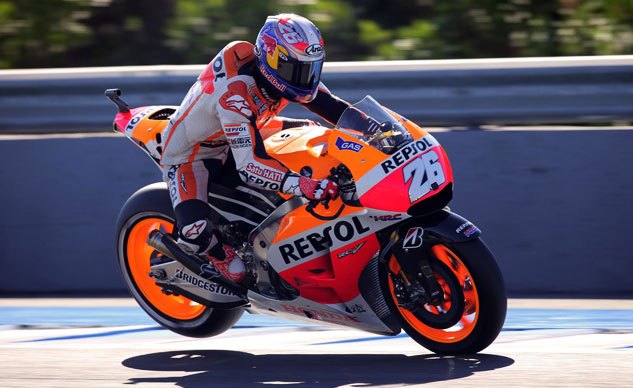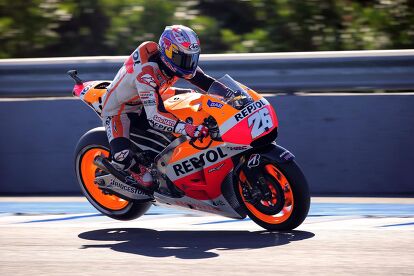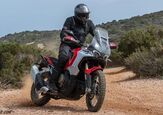Should I Use The Rear Brake or Not?
Dear MOby,
I’m proud that I caught on pretty quick that people who say “Never use the front brake or you’ll go over the handlebars” are FOS. But now that I’ve been riding my new (to me) ’08 SV650 about six months, some pretty experienced people I know are telling me never to use the rear brake. They say it’s too easy to lock up and send you into a skid and into the weeds, and why risk that since the rear doesn’t contribute much stopping power anyway? What do you think? Why is it there if you’re not supposed to use the rear brake, is it just an emergency back-up system?
Rear Curious
Dear Rear,
Although it is true that the vast majority of total decelerative force is provided by the front brake in the vast majority of pavement situations, the only time you shouldn’t use the rear brake is when it’s in the air, like Dani Pedrosa’s is here. How much rear brake you can use depends on the kind of bike you’re riding: The more weight you have over the rear wheel (big cruisers and touring bikes), the more rear brake you can use of course, without locking up the tire. Sporty bikes, with their shorter wheelbases and higher center of gravity, pitch forward during braking much more dramatically, reducing the effectiveness of the rear brake.
I was never much of a rear brake guy until I started riding dirt bikes a little, specifically TT-R125 Yamahas at the local vet track. On dirt, the rear brake’s almost indispensable, as you use it to kick the rear end out going around tight corners, for slowing down with your weight slid onto the back of the seat on downhill sections, et cetera. Since the rear’s usually sliding around anyway on dirt, the rear brake is very effective, and you get used to applying it in conjunction with the front to balance the bike when you’re back on pavement.
Later, at Colin Edwards’ Texas Tornado Boot Camp on yet another TT-R, the great Joe Prussiano answered the rear-brake question by stating, “When I wanna stop, I want all the brakes I can get.” Well, that’s racing on dirt, and you probably seldom need to stop with maximum decel on the street on your SV. For serious sport riding, though, the rear brake is still a great tool for controlling your motorcycle. It’s important enough that Mick Doohan had a thumb-operated rear brake built for his NSR500 Honda after his ankle got smashed up, and used it to win five straight 500cc championships beginning in 1994. On those 500cc beasts BTC (Before Traction Control), they’d use the rear to control wheelspin and wheelies, and without it Doohan said his Honda was unrideable.
In the real world, the rear’s most useful when you find yourself (or perceive yourself to be) in a corner too fast. Applying a little rear brake will slow you down and tighten your line, while eliminating the danger of too much front brake locking the front wheel. Aggressively trail-braking into corners (turning while braking) is smoother and more natural if you use both brakes; applying a bit of rear brake helps the rear of the bike stay settled.
The reason you’ve only got one small rear brake is by design; the manufacturer is trying to help you not lock it up. You can help them help you by adjusting the pedal so that you’re not applying much pressure until you’ve got some real ankle flexion happening; in other words, adjust the lever a bit low. (One of the lesser benefits of ABS is the ability to drag the rear around corners with zero danger of locking it up.)
On the road, the rear brake is kind of a finesse tool. You don’t have to use it, but if you learn to use it, you’ll ride smoother and safer.
Send your moto-related questions to AskMOAnything@motorcycle.com. If we can’t answer them, we’ll at least make you feel temporarily better by thinking you’re talking to somebody who knows what they’re talking about even if we don’t. It’s the thought that counts.
Recent Ask MOs:
Is There A Law Against Holding Up Traffic In The Left Lane?
Which is it: Lb-ft or Ft-lbs?
My Brand New Tire has a Nail in it!
More by John Burns
































Comments
Join the conversation
I use the rear brake in downhill sections, just a little to keep stable and keep all the weight from shifting too far forward under braking. I also leave the rear on a little after I ease off the front when braking hard(ish) into corners; I get a little more stability without making the steering slow as much (it seems). Of course every bike is different - the unit on a previous ride (Ducati 1198) was nearly useless, where the rear brake on my ZRX1200R has real effect (to name the two extremes I've experienced)
Bike dependent. Cruisers get a LOT of extra stopping power from the rear. Sporty bikes tend to lighten the rear to the point that it'll lockup and fishtail very easily. If it's in the air, you can brake on it all you want, it just won't do anything.
Agree completely about using it to set corner line and speed on the street.